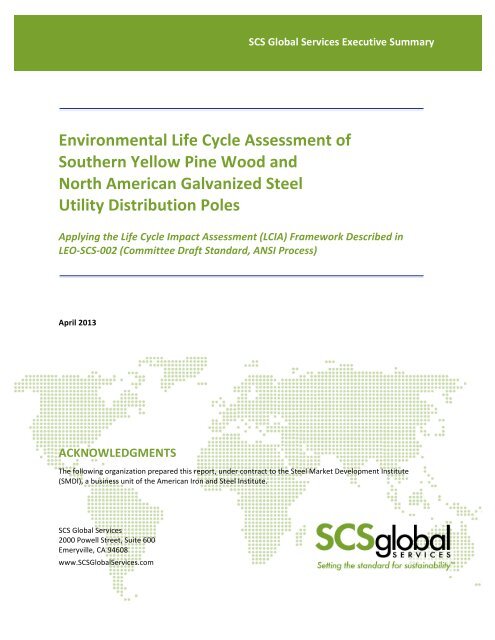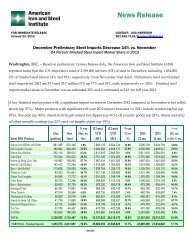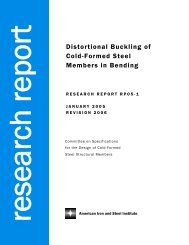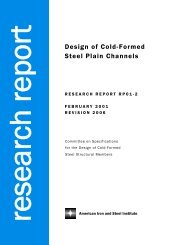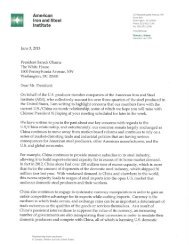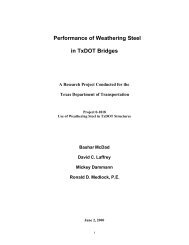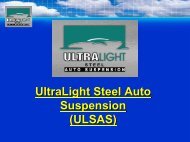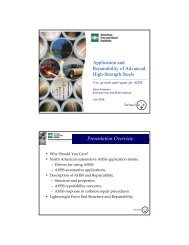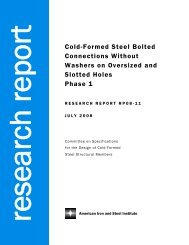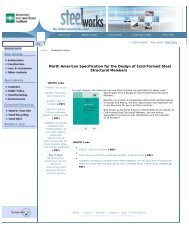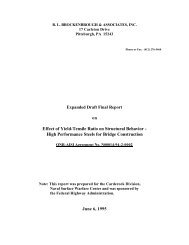Environmental Life Cycle Assessment of Southern Yellow Pine ...
Environmental Life Cycle Assessment of Southern Yellow Pine ...
Environmental Life Cycle Assessment of Southern Yellow Pine ...
Create successful ePaper yourself
Turn your PDF publications into a flip-book with our unique Google optimized e-Paper software.
FINAL REPORT<br />
SCS Global Services Executive Summary <br />
SCS Global Services Report <br />
<strong>Environmental</strong> <strong>Life</strong> <strong>Cycle</strong> <strong>Assessment</strong> <strong>of</strong> <br />
<strong>Southern</strong> <strong>Yellow</strong> <strong>Pine</strong> Wood and <br />
North American Galvanized Steel <br />
Utility Distribution Poles <br />
Applying the <strong>Life</strong> <strong>Cycle</strong> Impact <strong>Assessment</strong> (LCIA) Framework Described in <br />
LEO-‐SCS-‐002 (Committee Draft Standard, ANSI Process) <br />
April 2013 <br />
ACKNOWLEDGMENTS <br />
The following organization prepared this report, under contract to the Steel Market Development Institute <br />
(SMDI), a business unit <strong>of</strong> the American Iron and Steel Institute. <br />
SCS Global Services <br />
2000 Powell Street, Suite 600 <br />
Emeryville, CA 94608 <br />
www.SCSGlobalServices.com
EXECUTIVE SUMMARY<br />
This publication should be cited in the literature in the following manner: <br />
<strong>Life</strong> <strong>Cycle</strong> <strong>Assessment</strong> <strong>of</strong> <strong>Southern</strong> <strong>Yellow</strong> <strong>Pine</strong> Wood and North American Galvanized Steel Utility Distribution Poles.<br />
Scientific Certification Systems, Emeryville CA: 2013.<br />
April 2013 | ©SCS Global Services
EXECUTIVE SUMMARY<br />
1 EXECUTIVE SUMMARY <br />
1.1 Introduction <br />
The American Iron and Steel Institute (AISI) estimates that approximately 185 million utility poles are <br />
in service in North America. 1 Wood poles comprise the majority <strong>of</strong> utility poles in the U.S. 2 However, <br />
some states and utilities have begun switching to steel poles, due to economical advantages over <br />
wood – for example, Nevada, Arizona in 1997, and Austin, Texas in the early 1990’s. 3,4 As different <br />
materials, steel and wood not only have different physical properties, but also different <br />
environmental impact pr<strong>of</strong>iles. <br />
The goal <strong>of</strong> this study is to use life cycle assessment (LCA) to compare the environmental <br />
performance <strong>of</strong> utility poles made from wood and galvanized steel. To achieve this goal, the study <br />
compares the use <strong>of</strong> utility poles in the Southeastern United States (US), made from each <strong>of</strong> these <br />
competing materials. Today, utility poles in this region are primarily wood made from <strong>Southern</strong> <br />
yellow pine, <strong>of</strong>ten treated with chromated copper arsenate (CCA); this study assesses the <br />
implications <strong>of</strong> replacing these wood poles with galvanized steel poles over time. <br />
This report provides a detailed documentation <strong>of</strong> a complex assessment. The intended audience <strong>of</strong> <br />
the Executive Summary is a knowledgeable member <strong>of</strong> the utility industry, while for the main body <strong>of</strong> <br />
the report, the intended audience is a knowledgeable LCA practitioner. <br />
The intended application <strong>of</strong> this study is the “consequential” life cycle assessment (LCA) comparing a <br />
system <strong>of</strong> wood utility poles, with a system <strong>of</strong> galvanized steel utility poles, in the Southeastern US. 5<br />
The study conforms to ISO-‐14044 and the LEO-‐SCS-‐002 Final Committee Draft Standard, 6 using <br />
advanced environmentally relevant indicators that provide a foundational basis for comparisons <br />
between the two systems. <br />
1 Utility Poles. American Iron & Steel Institute. [http://www.smdisteel.org/en/Construction/Utility%20Poles.aspx] Accessed <br />
3/28/13. <br />
2 Shaban, A.O. Power Pole Research. Cal Poly San Luis Obispo, Electrical Engineering. 1/14/02. <br />
3 Oliver, D., Arizona Public Service Co. APS Selects Steel. Transmission & Distribution World. 8/1/01. <br />
[http://tdworld.com/mag/power_aps_selects_steel/index.html] <br />
4 Padavick, J., Austin Energy. Austin Energy Embraces Steel. Transmission & Distribution World. 7/1/03. <br />
[http://tdworld.com/mag/power_austin_energy_embraces/index.html] <br />
5 Use <strong>of</strong> the term “consequential” LCA refers to a <strong>Life</strong> cycle assessment that addresses both the primary consequences (i.e., <br />
biophysical impacts, for better or worse) <strong>of</strong> an industrial system, as well as the secondary consequences that can occur <br />
when one system is substituted for another based on changes in production markets. <br />
6 Type III <strong>Life</strong>-‐<strong>Cycle</strong> Impact Pr<strong>of</strong>ile Declarations for Products, Services, and Systems, is being developed under the open <br />
American National Standards Institute (ANSI) Process, administrated by the Leonardo Academy. See <br />
http://www.leonardoacademy.org/services/standards/life-‐cycle.html <br />
April 2013 | ©SCS Global Services <br />
ES-‐ 1
EXECUTIVE SUMMARY<br />
1.2 Summary <strong>of</strong> Findings <br />
This study compared two scenarios: Business-‐As-‐Usual (BAU) and Steel Pole Replacement (SPR), <br />
comparing the implications <strong>of</strong> the use <strong>of</strong> wood and galvanized steel utility poles in the Southeast. Of <br />
the thirty-‐five independent category indicators that were assessed and quantified: <br />
• 21 indicators show a clear benefit (a difference <strong>of</strong> 25% or more) in terms <strong>of</strong> lower impact <br />
levels associated with the use <strong>of</strong> galvanized steel utility poles under the SPR scenario. For 12 <br />
<strong>of</strong> these indicators, the difference was 100% or greater. <br />
• 4 indicators do not show a clear advantage toward either the SPR or BAU scenario, differing <br />
by less than 25%. For these indicators, results are within the margin <strong>of</strong> error, considering the <br />
uncertainties in the inventory and environmental characterization data used in the <br />
assessment.<br />
• 10 show a clear benefit in terms <strong>of</strong> lower impact levels associated with the use <strong>of</strong> wood <br />
utility poles under the BAU scenario. For 5 <strong>of</strong> these indicators, the difference was 100% or <br />
greater. <br />
Five additional impact categories were identified as environmentally relevant but could not be <br />
quantified due to insufficient data. However, impact reductions <strong>of</strong> 100% or greater favoring the SPR <br />
scenario would be anticipated if measurements were possible, based on available information. This <br />
categories include: the exposure <strong>of</strong> humans, flora, and fauna to toxic substances, resulting from <br />
arsenic ore extraction and refining in China; the exposure <strong>of</strong> workers to toxic herbicides in the <br />
Southeastern US as a result <strong>of</strong> herbicide application associated with forestry operations in this region; <br />
disturbance to wetland and freshwater biomes in the Southeastern US, resulting from forestry in this <br />
region; disturbance to suitable freshwater and wetland habitats for species in the Southeastern US, <br />
resulting from forestry in this region. <br />
The findings are summarized in Table 1 below. In the table, Indicator results are reported by Impact <br />
category. If there are multiple indicators per impact category, these are bulleted and listed <br />
separately. For indicators measuring net impacts, breakout data are provided in italics. Negative <br />
results indicate cooling effects from greenhouse gases and black carbon, or avoided depletion as a <br />
secondary consequence related to reduced extraction <strong>of</strong> metal ores. <br />
The study findings should not be interpreted to imply that all environmental indicators should be <br />
“weighted” equally, but rather, that individual indicators should be considered separately in their <br />
appropriate context. <br />
Further discussion <strong>of</strong> the scenarios studied and the key findings are found in the remainder <strong>of</strong> the <br />
Executive Summary. <br />
April 2013 | ©SCS Global Services <br />
ES-‐ 2
EXECUTIVE SUMMARY<br />
Table 1. Summary <strong>of</strong> results for each scenario, by category indicator. All values are rounded. All tons are <br />
metric tons. For most indicators, the margin <strong>of</strong> error is expected to be approximately ± 25%. <br />
Impact Categories and Indicators Units BAU Results <br />
SPR <br />
Results <br />
Extracted Resource Depletion <br />
Energy Resource Depletion Thousand Barrels <strong>of</strong> Oil eq. 698 364 <br />
Water Use Thousands <strong>of</strong> acre-‐feet 299 185 <br />
Metals and Minerals Resource Depletion <br />
• Arsenic Resource Depletion Tons Arsenic (As) eq. 3,380 0 to -‐4,000* <br />
• Barite Resource Depletion Tons Barite (BaSO 4) eq. 62 54 <br />
• Boron Resource Depletion kg Boron Trioxide (B 2O 3) eq. 1,150 720 <br />
• Chromium Resource Depletion Tons Chromium (Cr) eq. 4,160 0 to -‐4,100* <br />
• Copper Resource Depletion Tons Copper (Cu) eq. 22 41 <br />
• Fluorspar Resource Depletion Tons Fluorspar (CaF 2) eq. 136 93 <br />
• Lead Resource Depletion kg Lead (Pb) eq. 849 2,830 <br />
• Manganese Resource Depletion Tons Manganese (Mn) eq. 17 11 <br />
• Nickel Resource Depletion Tons Nickel (Ni) eq. 48 17 <br />
• Tin Resource Depletion kg Tin (Sn) eq. 149 112 <br />
• Zinc Resource Depletion Tons Zinc (Zn) eq. 43 26,100 <br />
Land Use Ecological Impact <br />
Terrestrial Biome Disturbance Acres fully disturbed biome eq. * yrs 0 615 <br />
• Western Great Lakes Forests Acres fully disturbed biome eq. * yrs 0 615 <br />
• Southeastern Mixed & Broadleaf Forest Acres fully disturbed biome eq. * yrs 276,000 0 <br />
• Southeastern Conifer Forest Acres fully disturbed biome eq. * yrs 202,000 0 <br />
Wetland Biome Disturbance <br />
Not measured <br />
Key Species Habitat Disturbance <br />
• Blanding’s turtle Acres fully disturbed habitat eq. * yrs 0 615 <br />
• Wood Turtle Acres fully disturbed habitat eq. * yrs 0 615 <br />
• Kirtland’s warbler Acres fully disturbed habitat eq. * yrs 0 615 <br />
• Red-‐Cockaded Woodpecker Acres fully disturbed habitat eq. * yrs 386,000 0 <br />
• Eastern indigo snake Acres fully disturbed habitat eq. * yrs 386,000 0 <br />
• Frosted flatwoods salamander Acres fully disturbed habitat eq. * yrs 153,000 0 <br />
• Gopher tortoise Acres fully disturbed habitat eq. * yrs 145,000 0 <br />
• Indiana bat Acres fully disturbed habitat eq. * yrs 386,000 0 <br />
• Red Wolf Acres fully disturbed habitat eq. * yrs 386,000 0 <br />
• Reticulated flatwoods salamander Acres fully disturbed habitat eq. * yrs 145,000 0 <br />
• Red-‐Cockaded Woodpecker (Nesting) Acres fully disturbed habitat eq. * yrs 540,000 0 <br />
Wetland & Freshwater Habitat Disturbance Not measured <br />
Impacts from GHG/BC Emissions <br />
Global Climate Change (Net) Thousands <strong>of</strong> tons CO 2 eq. 277 114 <br />
Warming Impacts Thousands <strong>of</strong> tons CO 2 eq. 474 286 <br />
Cooling Impacts Thousands <strong>of</strong> tons CO 2 eq. -‐197 -‐170 <br />
Arctic Climate Change Thousands <strong>of</strong> tons CO 2 eq. 23 28 <br />
Ocean Acidification Thousands <strong>of</strong> tons CO 2 226 237 <br />
Ocean Thermal Loading (Net) Thousands <strong>of</strong> tons CO 2 eq. 460 417 <br />
Ocean Warming Thousands <strong>of</strong> tons CO 2 eq. 618 553 <br />
Ocean Cooling Thousands <strong>of</strong> tons CO 2 eq. -‐158 -‐136 <br />
<strong>Environmental</strong> Impacts from Emissions <br />
Regional Acidification Tons <strong>of</strong> SO 2 eq. 2,470 3,670 <br />
Ecotoxicity <br />
Not measured <br />
Human Health Impacts from Emissions <br />
Ground Level Ozone Exposure Risks Persons * hours * ppm O 3 45,000 74,000 <br />
PM2.5 Exposure Risks Persons * hours * µg PM2.5 eq. / m 3 15,000 23,000 <br />
Toxic Air Emissions – Effects from Inhalation Not measured <br />
Toxic Emissions – Effects from Ingestion Not measured <br />
Risks from Untreated Hazardous Waste <br />
CCA-‐Treated Pole Disposal Tons <strong>of</strong> CCA-‐treated wood 593,000 162,000 <br />
*Accounts for the avoided depletion <strong>of</strong> arsenic and chromite ore as a result <strong>of</strong> avoided CCA production in the SPR scenario. <br />
April 2013 | ©SCS Global Services <br />
ES-‐ 3
EXECUTIVE SUMMARY<br />
1.3 Scope <br />
1.3.1 Utility Pole System <br />
This study assessed the use <strong>of</strong> one million distribution poles, including production, installation, <br />
upkeep, and disposal <strong>of</strong> the poles over a 40-‐year period in the Southeastern US. It is assumed that <br />
poles are uniformly distributed across the region, falling under the purview <strong>of</strong> the <strong>Southern</strong> Electrical <br />
Reliability Council (SERC); this region represents most <strong>of</strong> the electrical distribution system in the <br />
Southeastern US. <br />
The pole height and class used in the utility pole system were chosen to be representative <strong>of</strong> a <br />
competitive pole specification. Steel poles are not typically competitive at present with the smaller <br />
Grade C wood poles and do not represent a realistic option for utilities. On the other hand, Class 2 <br />
steel poles are economically competitive with Grade B wood poles and are more likely to be <br />
considered by a utility interested in alternatives to wood. <br />
In terms <strong>of</strong> design criteria, pole height is based mostly on desired clearance from surroundings. Most <br />
wood distribution poles in operation in this region are estimated to be between 35 and 50 feet tall. 7<br />
SCS selected a representative pole <strong>of</strong> each type <strong>of</strong> material for use in this study: <br />
<br />
<br />
Wood poles made from <strong>Southern</strong> yellow pine, grown in the Southeastern US, and treated <br />
with chromated copper arsenic (CCA). <br />
Steel pole: galvanized steel produced using North American hot rolled steel coil. <br />
1.3.1.1 Average Service <strong>Life</strong>times <br />
In this study, the average service lifetime was estimated for each material type; this average lifetime <br />
was used to calculate annual average failure rates, determining the number <strong>of</strong> poles requiring <br />
replacement in each year <strong>of</strong> the study time horizon. These annual average failure rates were <br />
assumed to include replacements due to pole failure, including: catastrophic failure due to weather <br />
and other causes; failure due to corrosion or decay; and replacement due to defective materials. The <br />
average service lifetimes used in the study are described in Sections 1.3.1.1.1 and 1.3.1.1.2. <br />
The replacement <strong>of</strong> poles for reasons other than failure (such as removal due to changes in right-‐<strong>of</strong>-way)<br />
was excluded from the assessment due to a lack <strong>of</strong> data. This bias does not significantly affect <br />
the results <strong>of</strong> the study, as pole failure is the dominant cause <strong>of</strong> pole replacements. <br />
1.3.1.1.1 Galvanized Steel Utility Poles <br />
While galvanized steel utility poles have not been used for a long enough period to determine <br />
average service lifetimes directly, research into similar steel structures, and known corrosion rates <br />
for galvanized steel, were used to estimate the average service lifetime. <br />
7 Shaban, A.O. Power Pole Research. Cal Poly San Luis Obispo, Electrical Engineering. 1/14/02. <br />
April 2013 | ©SCS Global Services <br />
ES-‐ 4
EXECUTIVE SUMMARY<br />
In North Carolina, lattice transmission structures made from galvanized steel have proved to have 80-‐<br />
year lifespans. 8 While structurally different from galvanized steel poles, the coating used is very <br />
similar to that used for galvanized steel poles, and similar lifetimes can be expected. <br />
The American Galvanizers Association provides estimates <strong>of</strong> the time to the first maintenance event <br />
for hot dipped galvanized steel based on the thickness <strong>of</strong> the zinc coating and the local climate (see <br />
Figure 1). <br />
Figure 1. Time to the first maintenance event for galvanized steel. 9<br />
Applying this coating thickness to Figure 1, the time to first maintenance event (i.e., 5% surface rust) <br />
for a galvanized pole can be estimated as 65 years for tropical marine climate, 73 years for temperate <br />
marine, 81 years for suburban, and over 100 years for rural. The tropical and temperate marine <br />
climates comprise a relatively small portion <strong>of</strong> the study area, with much larger portions <strong>of</strong> the region <br />
represented by suburban and rural climates. Steel poles exhibiting surface rust may be coated, and <br />
the life <strong>of</strong> the pole extended beyond those estimates in Figure 1. <br />
Based on this evidence, the average service lifetime <strong>of</strong> steel utility distribution poles in the US <br />
Southeast is estimated to be 80 years, corresponding to an annual average failure rate <strong>of</strong> 1.25%. <br />
Regular application <strong>of</strong> surface retreatments would likely extend the average service lifetime <strong>of</strong> steel <br />
poles beyond 80 years; however, these retreatments are not included in this study. <br />
1.3.1.1.2 Wood Utility Poles <br />
It was determined that pole purchasers (i.e., utilities) would have the best understanding <strong>of</strong> the <br />
average service lifetime <strong>of</strong> wood poles. According to a survey <strong>of</strong> over 260 utilities in the US, with a <br />
8 Terry, T. Tennessee Valley Authority. TVA Linemen Install Poles in Hard-‐to-‐Reach Areas. Transmission & Distribution World. <br />
7/1/08. <br />
9 Hot-‐Dip Galvanizing for Corrosion Protection – a Specifier's Guide.” American Galvanizers Association. 2012. <br />
http://www.galvanizeit.org/images/uploads/publicationPDFs/Galvanized_Steel_Specifiers_Guide.pdftracked=yes <br />
April 2013 | ©SCS Global Services <br />
ES-‐ 5
EXECUTIVE SUMMARY<br />
sample representing ~25% <strong>of</strong> poles in service, utilities have estimated the average wood pole service <br />
life as between 30 and 40 years. 10 This study uses the top end <strong>of</strong> the range from the survey: 40 years, <br />
corresponding to an annual average failure rate <strong>of</strong> 2.5%. <br />
1.3.2 Selected Functional Unit and Study Time Horizon <br />
For this study, the functional unit is the use <strong>of</strong> a system <strong>of</strong> one million 45-‐foot tall, Class 2/Grade B 11<br />
distribution poles over a 40-‐year period in the Southeastern US. In order to examine life cycle <br />
impacts <strong>of</strong> the poles in the most straightforward manner possible, this study assumes that steel and <br />
wood utility poles are functionally equivalent from the perspective <strong>of</strong> utility providers, and can be <br />
substituted on a one-‐to-‐one basis. <br />
This use encompasses only the required load-‐bearing support for distribution wires used in local <br />
power and telecommunications applications, not the use <strong>of</strong> the distribution wire infrastructure itself <br />
(i.e., electrical power distribution is excluded from the scope). The use <strong>of</strong> the wire infrastructure does <br />
not vary based on the type <strong>of</strong> support structure used, and was excluded from the scope. <br />
Additionally, the functional unit reflects the infrastructure required for supporting local distribution, <br />
not regional transmission, which requires a substantially different support infrastructure. A third <br />
alternative, the burial <strong>of</strong> distribution wires was not included in the study, as the goal <strong>of</strong> the study is to <br />
help inform decision-‐making between different pole material options. <br />
The timeframe <strong>of</strong> 40 years was chosen to capture differences in durability between the poles. The <br />
dynamics <strong>of</strong> the utility pole system over this 40-‐year period were assessed by including results at the <br />
beginning <strong>of</strong> the time horizon, and after 10, 20, 30, and 40 years. This provides clear “snapshots” <strong>of</strong> <br />
the benefits and trade-‐<strong>of</strong>fs <strong>of</strong> phasing in steel poles at several points in time. <br />
1.3.3 Scenarios Considered in the <strong>Assessment</strong> <br />
The study considers the use <strong>of</strong> the utility system in the Southeast given two different scenarios, with <br />
a scope that is cradle-‐to-‐grave for both: <br />
The “business-‐as-‐usual” scenario (“BAU” scenario). As Class 2 wood poles fail, they continue <br />
to be replaced by Class 2 wood poles. This is the typical practice in the region. <br />
The “steel pole replacement” scenario (“SPR” scenario). As Class 2 wood poles fail, they are <br />
instead replaced by Grade B galvanized steel utility poles. <br />
In both the BAU and SPR scenarios, the total number <strong>of</strong> utility poles in operation is held constant at <br />
one million poles, maintaining the same functional equivalency. The consequences to human health <br />
and the environment as a result <strong>of</strong> these two scenarios were assessed over a 40-‐year time horizon; <br />
the total number <strong>of</strong> poles <strong>of</strong> each type in service, for both scenarios, is shown in Figure 2. As can be <br />
seen, in the SPR scenario, after 40 years most (over 60%) utility poles are galvanized steel. <br />
10 Wood Pole Purchasing, Inspection, and Maintenance: A Survey <strong>of</strong> Utility Practice. Mankowski, M., et al. Forest Products <br />
Journal. 52(11/12): 43-‐50. 2002. <br />
11 IEEE 2012 National Electrical Safety Code (NESC). NESC-‐2012. IEEE Standards. 2012. <br />
April 2013 | ©SCS Global Services <br />
ES-‐ 6
EXECUTIVE SUMMARY<br />
number <strong>of</strong> poles in operavon <br />
1,200,000 <br />
1,000,000 <br />
800,000 <br />
600,000 <br />
400,000 <br />
200,000 <br />
-‐ <br />
2011 <br />
2013 <br />
2015 <br />
2017 <br />
2019 <br />
2021 <br />
2023 <br />
2025 <br />
2027 <br />
2029 <br />
2031 <br />
Year <br />
Wood Poles (BAU) Steel Poles (SPR) Wood Poles (SPR) <br />
2033 <br />
2035 <br />
2037 <br />
2039 <br />
2041 <br />
2043 <br />
2045 <br />
2047 <br />
2049 <br />
2051 <br />
Figure 2. The number <strong>of</strong> wood and steel poles in service over the study time horizon in each scenario. <br />
1.3.3.1 Reference Flows <br />
The reference flows required to fulfill the functional unit are examined for both scenarios to <br />
understand the implications to human health and the environment from these differing material <br />
choices. 12 In each scenario, there are four reference flows required to fulfill the function expressed by <br />
the functional unit, which is the maintenance <strong>of</strong> a system <strong>of</strong> 1 million utility poles. These four outputs <br />
are: production <strong>of</strong> utility poles (including installation); inspection <strong>of</strong> utility poles; retreatment <strong>of</strong> <br />
utility poles; and disposal <strong>of</strong> utility poles. In the SPR scenario, these outputs include the inspection, <br />
retreatment, and disposal, <strong>of</strong> wood poles that were in place in at the beginning <strong>of</strong> the study time <br />
horizon. The reference flows for 10-‐year intervals within the study time horizon are shown in Table <br />
and Table 3. <br />
Table 2. Reference flows for BAU scenario. Values shown are the reference flows in the year <strong>of</strong> the time <br />
horizon shown. <br />
BAU Scenario <br />
Year <br />
Poles Produced <br />
(Wood) <br />
Pole Inspections <br />
(Wood) <br />
Pole Retreatments <br />
(Wood) <br />
Poles Landfilled <br />
(Wood) <br />
2012 25,000 125,000 66,667 25,000 <br />
2022 25,000 125,000 66,667 25,000 <br />
2032 25,000 125,000 66,667 25,000 <br />
2042 25,000 125,000 66,667 25,000 <br />
2052 25,000 125,000 66,667 25,000 <br />
12 Reference flows are defined in the ISO-‐14040 standard as the “measure <strong>of</strong> the outputs from processes in a given<br />
product system required to fulfill the function expressed by the functional unit.”<br />
April 2013 | ©SCS Global Services <br />
ES-‐ 7
EXECUTIVE SUMMARY<br />
Table 3. Reference flows for SPR scenario. Values shown are the reference flows in the year <strong>of</strong> the time <br />
horizon shown. <br />
SPR Scenario <br />
Year <br />
Poles <br />
Produced <br />
(Steel) <br />
Pole <br />
Inspections <br />
(Steel & <br />
Wood) <br />
Pole <br />
Retreatments <br />
(Wood) <br />
Poles <br />
Landfilled <br />
(Wood) <br />
Poles <br />
Recycled <br />
(Steel) <br />
Poles <br />
Landfilled <br />
(Steel) <br />
2012 25,000 125,000 66,667 25,000 0 0 <br />
2022 22,702 97,041 51,755 19,408 2,962 76 <br />
2032 20,420 94,806 40,179 15,067 5,026 129 <br />
2042 18,648 75,967 31,192 11,697 6,628 170 <br />
2052 17,273 76,316 24,215 9,081 7,871 202 <br />
The number <strong>of</strong> poles required to be produced is significantly less for the SPR scenario, due to the <br />
longer average service lifetime <strong>of</strong> galvanized steel utility poles. The number <strong>of</strong> required inspection <br />
events is also less, as steel poles require less frequent inspections than wood poles. <br />
1.3.4 Unit Processes included in the Scenarios <br />
The unit processes included in the scope <strong>of</strong> the SPR scenario are those that are affected by the <br />
production, inspection, retreatment, or disposal <strong>of</strong> poles occurring in this scenario. This includes unit <br />
processes that are affected by the continuing inspections, re-‐treatments, and disposal <strong>of</strong> wood poles <br />
currently in service, as well as those unit processes affected by steel utility pole production, <br />
maintenance and disposal. These unit processes must increase or maintain their output to meet <br />
market demand in the SPR scenario. Impacts from these unit processes are the primary consequences <br />
<strong>of</strong> the SPR scenario. <br />
The scope additionally includes those unit processes that show a significant decrease in operations <br />
from decreased market demand due to the declining use <strong>of</strong> wood utility poles; these are secondary <br />
consequences <strong>of</strong> the SPR scenario. In the SPR scenario, the assessment considers a strategy <strong>of</strong> utility <br />
pole deployment <strong>of</strong> sufficient scale to have large-‐scale consequences in other product systems, such <br />
as the production <strong>of</strong> CCA treatment chemical. This scope is required for an LCA with this goal, <br />
according to the additional references <strong>of</strong> the LEO-‐SCS-‐002 standard. 13<br />
Five primary considerations were used to identify the unit processes included in the scope <strong>of</strong> the <br />
analysis, affected by the secondary consequences <strong>of</strong> the SPR scenario: <br />
1. The geographical scale and time horizon <strong>of</strong> the potential change to unit processes. <br />
2. The current limits <strong>of</strong> the market supplied by each unit process, including thresholds. <br />
3. Trends in the volume <strong>of</strong> the market for the product supplied by the unit process. <br />
13 See Provisions 6.5.4. and 7.2.4 <strong>of</strong> the International Reference <strong>Life</strong> <strong>Cycle</strong> Data System: ILCD handbook. General guide for <br />
<strong>Life</strong> <strong>Cycle</strong> <strong>Assessment</strong>-‐Detailed Guidance. First edition. Joint Research Center <strong>of</strong> the European Commission. 2010. The <br />
decision context <strong>of</strong> this LCA is considered to be “Situation B” under this handbook, corresponding to an LCA providing <br />
“decision support for strategies with large-‐scale consequences in the background system or other systems.” <br />
April 2013 | ©SCS Global Services <br />
ES-‐ 8
EXECUTIVE SUMMARY<br />
4. Changes in supply and demand for the product supplied by the unit process, and its required <br />
inputs. <br />
5. The relative scale <strong>of</strong> production <strong>of</strong> the unit process to the total relevant market. <br />
These guidelines are based on research to date in consequential LCA modeling. 14,15 In the SPR <br />
scenario, wood utility pole production is reduced by 25,000 each year; utility pole inspections decline <br />
by 40% after 40 years; and the required number <strong>of</strong> CCA-‐treated wood poles that must be disposed <strong>of</strong> <br />
each year decreases by over 20,000 by the end <strong>of</strong> the study time horizon. It is anticipated that these <br />
declines in production, inspections, and pole disposals will result in market effects affecting several <br />
unit processes. <br />
The unit processes included in the scope <strong>of</strong> the BAU scenario are those that are affected by the <br />
production, inspection, retreatment, and disposal <strong>of</strong> wood poles in this scenario. Since this scenario <br />
describes the utility pole system in the Southeastern US as it exists today, these unit processes are <br />
active currently. As there are no projected changes in market dynamics for any product systems for <br />
the BAU scenario, there are no secondary consequences. While the unit processes included in the <br />
SPR scenario include both primary and secondary consequences, the BAU scenario includes only <br />
primary consequences <strong>of</strong> wood utility pole production, inspection, retreatment, and disposal. <br />
The key unit processes that are major contributors to final indicator results are shown for both <br />
scenarios in Table . <br />
Table 4. Key unit processes included in the scope <strong>of</strong> assessment for the two scenarios. <br />
SPR Scenario <br />
BAU Scenario <br />
Iron Ore Mining in North America <br />
Forest Management and Timber Harvest for Utility Poles <br />
Zinc Ore Mining <br />
Milling and Kiln Drying <br />
Steel Production <br />
Pressure Treatment <br />
Pole Fabrication <br />
Chromated and Copper Arsenate (CCA) Chemical Production <br />
Galvanization <br />
Installation <strong>of</strong> Wood Utility Poles <br />
Zinc Smelting <br />
Maintenance <strong>of</strong> Wood Utility Poles <br />
Transportation <br />
Pesticide Production for Pole Maintenance <br />
Installation <strong>of</strong> Steel Utility Poles <br />
Other Use Phase Impacts for Wood Utility Poles <br />
Maintenance <strong>of</strong> Steel Utility Poles <br />
End-‐<strong>of</strong>-‐<strong>Life</strong> for Wood Utility Poles <br />
End-‐<strong>of</strong>-‐<strong>Life</strong> for Steel Utility Poles <br />
Reduction in Wood Pole Pressure Treatment <br />
Reduction in Chromated Copper Arsenate (CCA) Chemical Production <br />
Reduction in Inspections <strong>of</strong> Wood Utility Poles <br />
Reduction in End-‐<strong>of</strong>-‐<strong>Life</strong> for Wood Utility Poles <br />
14 Ibid. <br />
15 Weidema BP, Ekvall T, Heijungs R (2009) Guidelines for application <strong>of</strong> deepened and broadened LCA. Technical Report <strong>of</strong> <br />
CALCAS project. http://www.calcasproject.net <br />
April 2013 | ©SCS Global Services <br />
ES-‐ 9
EXECUTIVE SUMMARY<br />
1.4 <strong>Life</strong> <strong>Cycle</strong> Inventory <br />
For galvanized steel poles, inventory data from the WorldSteel Association representing North <br />
American hot rolled coil steel was used to model steel production and associated upstream <br />
processes. Pole fabrication data were available directly from participating suppliers in Canada <br />
(Ontario) and the US Midwest (Kansas). This study assumes a 50/50% split in pole production from <br />
these two fabricators. The electricity supply mix from appropriate regional grids was used for each <br />
fabricator, calculated according to data for the relevant North American Electric Reliability Council <br />
(NERC) region. These data were used in lieu <strong>of</strong> the national average <strong>of</strong> electricity generation data. All <br />
other unit processes were modeled using representative data from the Ecoinvent 16 and US LCI 17<br />
databases. <br />
For wood poles, the Timber Product Output Reports and Forest Inventory Data Online (FIDO) <br />
databases provided by the Forest Inventory and Analysis (FIA) Research Work Unit <strong>of</strong> the USDA <br />
Forest Service (USFS) were used to quantify land use impacts and timber and pole production <br />
statistics. 18 SCS data for CCA production were based on a previous SCS study for the production <strong>of</strong> a <br />
50% solution <strong>of</strong> this chemical. Specific data for the retreatment pesticides were not available; <br />
instead, this study used data for production <strong>of</strong> a generic pesticide. 19 Data for application quantities <br />
<strong>of</strong> pesticide were based on publically available information for pesticide treatment depth and <br />
thickness. The electricity supply was modeled in the same fashion as for steel utility poles, based <br />
upon the relevant NERC regions. All other unit processes were modeled using generic data from the <br />
Ecoinvent and US LCI databases. <br />
1.5 Discussion <strong>of</strong> the <strong>Environmental</strong> Advantages <strong>of</strong> SPR Scenario <br />
1.5.1 Lower Greenhouse Gas and Aerosol Emissions Contributing to Global Climate Change <br />
When considered over the entire 40-‐year time horizon, the accumulated emissions contributing to <br />
Global Climate Change are higher for the BAU scenario (see Table 1). In the BAU scenario, the major <br />
contributors to these results are: electricity generation required for the production <strong>of</strong> CCA treatment <br />
chemical; installation <strong>of</strong> wood poles; and the production <strong>of</strong> wood from <strong>Southern</strong> yellow pine, from <br />
forest management practices including predominantly short-‐rotation, even-‐aged forest <br />
management. These forest management practices in the Southeastern United States result in losses <br />
<strong>of</strong> forest carbon storage <strong>of</strong> between 20 to 30%, equivalent to the loss <strong>of</strong> storage <strong>of</strong> 20 to 40 tons <strong>of</strong> <br />
carbon dioxide per acre. In the SPR scenario, the largest contributors are the production <strong>of</strong> steel, <br />
galvanization, and zinc smelting. <br />
16 Ecoinvent v2.2. Swiss Centre for <strong>Life</strong> <strong>Cycle</strong> <strong>Assessment</strong>. <br />
17 US <strong>Life</strong>-‐<strong>Cycle</strong> Inventory Database http://www.nrel.gov/lci/ <br />
18 Accessible at http://srsfia2.fs.fed.us/ <br />
19 pesticide unspecified, at regional storehouse, RER, [kg] (#116). Ecoinvent v.2.2. 2010. Swiss Centre for <strong>Life</strong> <strong>Cycle</strong> <br />
Inventories. <br />
April 2013 | ©SCS Global Services <br />
ES-‐ 10
EXECUTIVE SUMMARY<br />
To better understand the significance <strong>of</strong> the indicator results for Global Climate Change shown in <br />
Table 1, an uncertainty analysis was conducted. This analysis included three contributions to <br />
uncertainty: <br />
<br />
<br />
<br />
Uncertainty related to Stressor Characterization Factors. The Intergovernmental Panel on <br />
Climate Change (IPCC) estimates that GWP factors for direct effects have an uncertainty <br />
<strong>of</strong> ±35% for the 5 to 95% confidence range. 20 This uncertainty was used for all S-‐CFs for <br />
this category indicator. <br />
Uncertainty related to inventory data. There was no way to evaluate the uncertainty <br />
related to inventory data in these scenarios. An uncertainty <strong>of</strong> ±15% for the 5 to 95% <br />
(90%) confidence range was assumed, considered to be reasonable given the overall data <br />
quality <strong>of</strong> the study, which used specific data for most <strong>of</strong> the key unit processes. <br />
Additional uncertainty in the environmental characterization factors used for sulfur <br />
dioxide emissions. This includes the uncertainty related to the Precursor Conversion <br />
Factor (P-‐CF) for sulfur dioxide forming tropospheric sulfate aerosols, and the uncertainty <br />
related to the trends in projections <strong>of</strong> these emissions over time. Recent research in <br />
establishing the P-‐CF independently found a factor very close to the value used in this <br />
study, suggesting the uncertainty is low. Furthermore, the sensitivity <strong>of</strong> results to the <br />
projections <strong>of</strong> sulfur dioxide emissions over time was found to be low, as described in <br />
Section 5 <strong>of</strong> the report body. 21,22 An additional uncertainty <strong>of</strong> ±15% for the 5 to 95% <br />
(90%) confidence range was used for results from sulfur dioxide emissions, in addition to <br />
the ±35% associated with GWPs for other substances. <br />
These three sources <strong>of</strong> uncertainty were combined in quadrature to obtain an overall uncertainty <strong>of</strong> <br />
±38% (±41% for the characterization <strong>of</strong> sulfur dioxide emissions) for both the BAU and SPR scenarios, <br />
which was used for the 90% confidence range. The category indicator results are shown in a whisker <br />
plot in Figure 3. <br />
20 Intergovernmental Panel on Climate Change: Fourth <strong>Assessment</strong> Report. Climate Change 2007: Working Group I: The <br />
Physical Science Basis. 2.10.2: Direct Global Warming Potentials. Retrieved on 8/2/2012 from <br />
http://www.ipcc.ch/publications_and_data/ar4/wg1/en/ch2s2-‐10-‐2.html <br />
21 Shindell, D.T., G. Faluvegi, D. M. Koch, G. A. Schmidt, N. Unger, S. E. Bauer. Improved Attribution <strong>of</strong> Climate Forcing to <br />
Emissions. 30 October 2009. Vol 326, 716-‐719. Science Magazine. <br />
22 Based on SCS internal data. <br />
April 2013 | ©SCS Global Services <br />
ES-‐ 11
EXECUTIVE SUMMARY<br />
800 <br />
thousands <strong>of</strong> tons <strong>of</strong> CO2 eq. <br />
600 <br />
400 <br />
200 <br />
0 <br />
-‐200 <br />
-‐400 <br />
-‐600 <br />
BAU SPR <br />
0 10 20 30 40 <br />
Time Horizon (years) <br />
Figure 3. A whisker plot <strong>of</strong> category indicator results for Global Climate Change (Net). The 90% confidence <br />
intervals are shown for all results in the time horizon, along with the first and third quartiles for each <br />
scenario. <br />
As this figure shows, there is an overlap in category indicator results for both the 90% confidence <br />
intervals, and the 50% confidence intervals, due to the uncertainties <strong>of</strong> the results in BAU and SPR <br />
scenarios. There are two main factors driving this uncertainty: <br />
• For the SPR scenario, the inclusion <strong>of</strong> the secondary consequences from avoided CCA <br />
production. If the secondary consequences are less significant than projected in these <br />
findings, the results become ambiguous between the two scenarios. <br />
• For both the BAU and SPR scenarios, the large uncertainty in the S-‐CF (the GWP). As noted, <br />
the IPCC estimates that GWPs have an uncertainty <strong>of</strong> ±35%, regardless <strong>of</strong> the time horizon <br />
used. This is a significant level <strong>of</strong> uncertainty; regardless <strong>of</strong> the inclusion <strong>of</strong> secondary <br />
consequences in the SPR scenario, the uncertainty in the S-‐CFs means that the two scenarios <br />
have a close overlap. This highlights the fact that the uncertainty in results for Global <br />
Climate Change, and more generally, those for carbon footprints, is much higher than is <br />
commonly understood. <br />
Based on this uncertainty analysis, it is estimated that there is an 70% likelihood that the SPR <br />
scenario has a lower indicator result for Global Climate Change (Net) after 40 years. These results <br />
show that the SPR scenario has an advantage over the BAU scenario for this category indicator, the <br />
scale <strong>of</strong> which is dependent on the size <strong>of</strong> the secondary consequences resulting from the <br />
introduction <strong>of</strong> steel utility poles. This result casts into question the common assumption that treated <br />
wood products have a lower carbon footprint than steel products. Depending on the market effects <br />
in the SPR scenario, there may be a marked benefit <strong>of</strong> the use <strong>of</strong> steel poles. <br />
April 2013 | ©SCS Global Services <br />
ES-‐ 12
EXECUTIVE SUMMARY<br />
1.5.2 Lower Land Use Ecological Impacts in Forests in the Southeastern United States <br />
While not directly comparable due to the different biomes and species affected, the scale <strong>of</strong> the <br />
results shown in Table 1 indicates that the land use ecological impacts in the SPR scenario are less. <br />
When averaged over the 40-‐year time horizon, the results for terrestrial biome disturbance are <br />
equivalent to the full disturbance <strong>of</strong> approximately 12,000 acres for the BAU scenario, compared to <br />
approximately 15 acres in the SPR scenario. <br />
The differential in the disturbance to wetlands is expected to be even larger; however, insufficient <br />
data were available to quantify these results. If data were available, it is anticipated that the <br />
differential between the two scenarios could be nearly four orders <strong>of</strong> magnitude. <br />
Based on what is known about wetlands and freshwater habitats in the Southeast US, the number <strong>of</strong> <br />
species impacted in the SPR scenario could be as little as 5% <strong>of</strong> that in the BAU scenario. This does <br />
not consider the impacted floral species, which is again expected to be a longer list for forestry. If <br />
data were available to quantify the severity and spatial extent <strong>of</strong> disturbance to suitable habitat for <br />
these species, the BAU scenario is expected to have indicator results three to four orders <strong>of</strong> <br />
magnitude higher than the SPR scenario, for many more species. <br />
Given these considerations, the reduction in land use ecological impacts is considered an advantage <br />
<strong>of</strong> the SPR scenario. <br />
1.5.2.1 Land Use Ecological Impacts from <strong>Southern</strong> <strong>Yellow</strong> <strong>Pine</strong> Production <br />
1.5.2.1.1 Terrestrial Biome Disturbance to Forests in the Southeast <br />
The United States Forest Service (USFS) estimates that in 2009 in the Southeast, roughly 55 million <br />
acres were covered in Loblolly-‐shortleaf pine forests, and 13 million acres were covered in Longleaf-slash<br />
forests, the two predominant forest types from which the <strong>Southern</strong> yellow pine used to <br />
produce the wood utility poles is sourced. Most forest management in the region utilizes even-‐aged <br />
forestry in “plantation” stands, where entire stands <strong>of</strong> forest are cut at one time, and allowed to re-grow<br />
before being cut again on a regular cycle. In the Southeastern US in 2007, 159 million out <strong>of</strong> 200 <br />
million acres were in plantations, accounting for nearly 80% <strong>of</strong> all timberland in the region. This type <br />
<strong>of</strong> forest management creates a landscape consisting <strong>of</strong> a patchwork <strong>of</strong> forests in different age <br />
classes (see Figure 4). <br />
April 2013 | ©SCS Global Services <br />
ES-‐ 13
EXECUTIVE SUMMARY<br />
Figure 4. A site in Alabama showing a patchwork <strong>of</strong> clear-‐cuts. The photo on the left was taken in January <br />
1999; the photo on the right in May 2007. Lat/Lon: 30°38'12.07"N, 85°47'35.52"W. <br />
Of the managed forests considered in the study scope that are producing <strong>Southern</strong> yellow pine, 97% <br />
are 40 years old or less; 75% are less than 20 years old. This indicates that the majority <strong>of</strong> wood <br />
produced in the region is from even-‐aged forestry, on rotation cycles less than 40 years. These <br />
practices impact two types <strong>of</strong> forest biome in the Southeast – “Temperate Broadleaf and Mixed <br />
Forest,” and “Temperate Coniferous Forest”. <br />
The managed forests in this region are maintained in an altered state compared to a mature forest, <br />
resulting in a set <strong>of</strong> land use ecological impacts that have altered plant communities in both <strong>of</strong> these <br />
biomes. These forest management practices have threatened the long-‐term persistence <strong>of</strong> many <br />
species, and a large part <strong>of</strong> the biomes has been converted to agriculture or plantation-‐based <br />
forestry. Longleaf-‐slash forests are currently on the decline across the entire region, as a result <strong>of</strong> fire <br />
suppression and conversion <strong>of</strong> forests to faster-‐growing loblolly-‐shortleaf forests. 23<br />
All <strong>of</strong> these impacts contribute to a biome that is disturbed across large areas <strong>of</strong> forest. Based on the <br />
study findings, the plantation style forestry in this region creates a landscape that is, on average, <br />
between 40% and 60% disturbed, when compared to a mature forest. <br />
1.5.2.1.2 Wetland Biome Disturbance <br />
As a result <strong>of</strong> forestry in the Southeastern US, a substantial number <strong>of</strong> wetlands in the Southeast <br />
have been disturbed since the baseline condition in the late 1880s. The hardwood species that can be <br />
planted and harvested in wetland areas are significantly less productive than <strong>Southern</strong> yellow pine <br />
species, and conversion from wetland forest to managed pine plantations accounts for most <strong>of</strong> the <br />
historic changes in the freshwater forested category <strong>of</strong> wetland in the Southeastern US. 24 Many <br />
wetlands have been drained (“de-‐watered”) and fully converted to harvestable forestland, resulting <br />
in full disturbance to the wetland biome over large areas. <br />
23 Forest Resources <strong>of</strong> the United States. United States Forest Service. 2007. <br />
24 U.S. Fish and Wildlife Service, Fisheries and Habitat Conservation: Status and Trends <strong>of</strong> Wetlands in the Conterminous <br />
United States, 1987-‐1998. (Report to Congress). T.E. Dahl. <br />
April 2013 | ©SCS Global Services <br />
ES-‐ 14
EXECUTIVE SUMMARY<br />
As well as the direct disturbance to converted wetlands, these activities indirectly affect downstream <br />
receiving water bodies and wetlands. Conversion <strong>of</strong> wetlands to forests leads to significant nutrient <br />
loadings from the decomposition <strong>of</strong> dewatered coastal plains soils, with affected downstream biomes <br />
including rivers, downstream freshwater wetlands, and coastal brackish wetlands. These indirect <br />
effects have resulted in large areas <strong>of</strong> wetlands experiencing partial disturbance throughout the <br />
Southeastern US, as wetlands are converted from one form to another (e.g., from forested <br />
freshwater wetland to emergent wetland). These impacts have resulted in disturbance to the <br />
hydrology <strong>of</strong> affected freshwater and wetland biomes over large areas. 25<br />
While disturbance to wetlands is still ongoing, the majority <strong>of</strong> wetland conversion occurred in the <br />
19 th and early 20 th century. From the 1780’s to the mid-‐1980’s, Alabama lost between 50-‐95% <strong>of</strong> its <br />
wetlands, with Georgia and Florida losing as much as 50%. 26 The conversion to even-‐aged plantation <br />
stands was at its peak in the early 1900s, when ambitious attempts to drain and convert wetlands <br />
were well underway. In the 1930's, the U.S. Government provided essentially free engineering <br />
services to farmers to drain wetlands; in the 1940's, the Government continued to share the cost <strong>of</strong> <br />
drainage projects. This included coordinated efforts to remove surface water from wetlands, <br />
resulting in notable wetland losses between 1900 and 1950 in Alabama, Georgia, and Florida. 27<br />
Even after this era <strong>of</strong> significant wetland conversion, until the mid-‐1990s, the impacts <strong>of</strong> forestry on <br />
wetlands were virtually unregulated. Activities such as earthmoving, planting, seeding, cultivating, <br />
minor drainage, and harvesting, were exempt from regulation under Section 404 <strong>of</strong> the Clean Water <br />
Act. 28 In the 1990s, state and federal government regulatory agencies began to provide guidance to <br />
clarify circumstances where forestry operations required permitting under the Clean Water Act.<br />
Permits were required, however, only in certain forested wetland types. <br />
While large-‐scale conversion rates <strong>of</strong> wetlands to forest management operations have declined in the <br />
region since the first half <strong>of</strong> the 20 th century, the converted and disturbed wetlands are in a <br />
persistently disturbed state; these impacts are still attributed to the wood utility pole system, due to <br />
the historical nature <strong>of</strong> the baseline condition. <br />
Additionally, disturbance is still occurring to wetlands as a result <strong>of</strong> silviculture. Some activities <br />
associated with forest plantations that cause disturbance to freshwater biome and wetlands include: <br />
site preparations and timber stand management practices that alter or eliminate site hydrology; <br />
construction <strong>of</strong> forest roads required to access cut timber sites; installation <strong>of</strong> drainage ditches <br />
through existing wetlands; bedding <strong>of</strong> sites; subsurface drainage; and levee construction, filling, and <br />
channelization (see Table 5). 29<br />
25 Personal correspondence, Steven I. Apfelbaum, Applied Ecological Services, Inc. Dated 3/22/3012, 4:13AM. <br />
26 Dahl, T.E. and G.J. Allord. 1996. History <strong>of</strong> wetlands in the conterminous United States. In. J. D. Fretwell, J.S. Williams, and <br />
P. J. Redman (compilers) National Water Summary on Wetland Resources. U.S. Geological Survey. <br />
27 Ibid. <br />
28 U.S. Fish and Wildlife Service, Fisheries and Habitat Conservation: Status and Trends <strong>of</strong> Wetlands in the Conterminous <br />
United States, 1987-‐1998 (Report to Congress). T.E. Dahl. <br />
29 Ibid. <br />
April 2013 | ©SCS Global Services <br />
ES-‐ 15
EXECUTIVE SUMMARY<br />
Figure 5. The drainage ditch in the foreground effectively altered wetland hydrology <br />
and was still functional several years following development <strong>of</strong> this pine plantation. <br />
Examples like this demonstrate the persistent wetland disturbance in the region. <br />
The first half <strong>of</strong> the 20 th century was the period since the baseline condition when the disturbance <br />
levels increased the most as a result <strong>of</strong> conversion to even-‐aged <strong>Southern</strong> yellow pine stands in the <br />
region. Since this period, the rate <strong>of</strong> wetland loss has declined by as much as 85% nationwide, when <br />
considering all causes. 30 However, the available data can only characterize impacts to wetlands in <br />
roughly the last 15 years. <br />
The scale <strong>of</strong> wetland conversion in the years for which data are available sets a lower bound on the <br />
disturbance level associated with Southeastern forestry; data from the United States Geological <br />
Survey (USGS) was used to understand the extent <strong>of</strong> wetlands converted for silviculture from 1986-‐<br />
2009. 31, 32,33 These data indicate that approximately 470,000 acres <strong>of</strong> freshwater wetlands were <br />
converted in this 23-‐year period nationwide, compared to approximately 14,000 acres <strong>of</strong> wetlands <br />
converted in the Mesabi Iron Range, the source <strong>of</strong> iron for North American steel production, since <br />
the late 1880s. <br />
Nationally, in the last 23 years, the wetland areas disturbed by silvicultural activities were 33 times <br />
greater than the wetland area disturbed in the Mesabi Iron Range in the last 130 years. In the early <br />
1900s, the rate <strong>of</strong> wetlands conversion in the Southeastern US was even higher. As such, the actual <br />
differential in wetlands conversion in the Southeastern US compared to the Mesabi Iron Range could <br />
be many times that level.<br />
30 U.S. Fish and Wildlife Service, Fisheries and Habitat Conservation: Status and Trends <strong>of</strong> Wetlands in the Conterminous <br />
United States, 2004-‐2009 (Report to Congress). T.E. Dahl. <br />
31 U.S. Fish and Wildlife Service, Fisheries and Habitat Conservation: Status and Trends <strong>of</strong> Wetlands in the Conterminous <br />
United States, 1987-‐1998. (Report to Congress). T.E. Dahl. <br />
32 U.S. Fish and Wildlife Service, Fisheries and Habitat Conservation: Status and Trends <strong>of</strong> Wetlands in the Conterminous <br />
United States, 1998-‐2004. (Report to Congress). T.E. Dahl. <br />
33 U.S. Fish and Wildlife Service, 2004-‐2009. <br />
April 2013 | ©SCS Global Services <br />
ES-‐ 16
EXECUTIVE SUMMARY<br />
1.5.2.1.3 Key Species Loss <br />
Key species included in the study were those on the US Forest Service (USFS) Threatened and <br />
Endangered Species list, or the International Union for the Conservation <strong>of</strong> Nature Red List <strong>of</strong> <br />
Threatened Species. 34,35 The assessment for terrestrial habitat disturbance was based on the same <br />
methods used to assess terrestrial biome disturbance; however, no data were available to quantify <br />
the spatial extent or severity <strong>of</strong> disturbance to wetland or freshwater habitats. The list <strong>of</strong> species <br />
impacted was compiled without assessment <strong>of</strong> these distinct category indicators. <br />
When considering the number <strong>of</strong> species impacted, the BAU scenario has higher impacts, affecting <br />
almost 90 species. Seven <strong>of</strong> these species experienced disturbance to terrestrial habitats, for which <br />
indicator results were assessed. An additional eighty-‐one <strong>of</strong> these species experienced disturbance to <br />
freshwater and/or wetland habitats; however, indicator results could not be quantified for these <br />
species, due to a lack <strong>of</strong> data. <br />
1.5.3 Lower Hazardous Emissions Associated with Impacts to Humans, Flora and Fauna <br />
Emissions from arsenic and chromite ore extraction, required for CCA production, have impacts that <br />
are significant in nature and large in spatial extent. Another impact to human health is the degree to <br />
which workers are exposed to toxic herbicides during forestry operations. These are primary <br />
consequences <strong>of</strong> the BAU scenario; the secondary consequences from implementation <strong>of</strong> the SPR <br />
scenario are projected to lead to a decline in arsenic ore mining and smelting activities in China, <br />
resulting in impact reductions for human health and the environment. <br />
1.5.3.1 Emissions from Arsenic Ore Extraction <br />
Due to environmental concerns from mining and smelting, arsenic trioxide has not been produced in <br />
the United States since 1985. In response to environmental concerns and human health issues, the <br />
wood-‐preserving industry made a voluntary decision to stop using CCA to treat wood for decks and <br />
outdoor residential use in 2003; however, because <strong>of</strong> known performance and lower costs, CCA is still <br />
used in nonresidential applications, such as the treatment <strong>of</strong> utility poles. 36<br />
Due to this voluntary ban on CCA use for most wood products, imports <strong>of</strong> arsenic trioxide (the <br />
primary chemical constituent <strong>of</strong> CCA) into the United States have declined since 2003 by roughly <br />
70%, when roughly 20,000 tons <strong>of</strong> this material was imported. The arsenic trioxide used in the BAU <br />
scenario is mined in China, by far the largest producer <strong>of</strong> arsenic trioxide worldwide. 37 China <br />
produces significant amounts <strong>of</strong> arsenic ores (primarily realgar and orpiment), and also manufactures <br />
34 United States Fish and Wildlife Service: Endangered Species Program. Species Searchmap. Accessed on 2/24/2012 from <br />
http://www.fws.gov/endangered/species/index.html. <br />
35 International Union for the Conservation <strong>of</strong> Nature: Red List <strong>of</strong> Threatened Species. Accessed on 2/24/2012 from <br />
http://www.iucnredlist.org/ <br />
36 USGS Minerals Commodity Summary 2012. Arsenic. http://minerals.usgs.gov/minerals/pubs/commodity/arsenic/mcs-‐<br />
2012-‐arsen.pdf <br />
37 The Encyclopedia <strong>of</strong> Earth: Arsenic. Retrieved on 4/6/2012 from <br />
http://www.eoearth.org/article/Arsenictopic=49557#gen1 <br />
April 2013 | ©SCS Global Services <br />
ES-‐ 17
EXECUTIVE SUMMARY<br />
arsenic trioxide from these materials. While no inventory or environmental characterization data for <br />
arsenic mining were available to calculate indicator results, case studies <strong>of</strong> several representative <br />
arsenic ore mining facilities in China were analyzed to determine the severity <strong>of</strong> impacts from this <br />
step in the supply chain for CCA production. Well documented impacts from arsenic mining and <br />
smelting were found: <br />
• A study <strong>of</strong> a site in Wenshan County in Yunnan Province, China, revealed impacts resulting <br />
from the mining and smelting <strong>of</strong> arsenic. This site was formerly an extensive mining and <br />
smelting complex, consisting <strong>of</strong> four arsenic processing plants several kilometers apart (see <br />
Figure 6). When the plant was closed in 2004, it had been operating for 40 years, resulting in <br />
decades <strong>of</strong> accumulated mining and smelting residues, all stored using primitive technology <br />
with no environmental protections. 38 At this site, residues from kilns used to smelt the <br />
arsenic ore (including oxidized arsenic fume) were shoveled and dumped over the hillside <br />
next to the facility parking lot; about 60,000 tons <strong>of</strong> residue are estimated at this single <br />
dumpsite. <br />
Figure 6. (Left) Refining process area, Wenshan site. 39 (Right) Area surrounding Wenshan arsenic mine site. <br />
In 2000, a tailings pond retention wall collapsed, discharging significant amounts <strong>of</strong> highly toxic arsenic <br />
residues into the rice paddies shown in the photograph. <br />
• A survey documented in 2000 the collapse <strong>of</strong> a dam for one <strong>of</strong> the tailings ponds at this site, <br />
causing arsenic residues to enter terraces <strong>of</strong> rice paddies, impacting dozens <strong>of</strong> terraced <br />
farms (see Figure 6). As a result <strong>of</strong> poor containment such as this, emissions <strong>of</strong> hazardous <br />
substances are expected on a regular basis. These emissions have resulted in the <br />
contamination <strong>of</strong> local streams to levels <strong>of</strong> more than 1.0 mg/L arsenic, significantly <br />
exceeding the 0.01 mg/L arsenic health thresholds identified by the US EPA. 40,41,42<br />
38 Remediation <strong>of</strong> Legacy Arsenic Mining Areas in Yunnan Province, China. Blacksmith Institute Journal <strong>of</strong> Health & Pollution. <br />
Vol. 1, No. 1-‐Feb 2011. Retrieved on 4/6/2012 from http://www.journalhealthpollution.org/ojs/ojs-‐<br />
2.2.4/index.php/journalhealthpollution/article/view/23/7 <br />
39 Ibid <br />
40 Ibid <br />
41 United States <strong>Environmental</strong> Protection Agency: Arsenic in Drinking Water. Retrieved on 4/6/2012 from <br />
http://water.epa.gov/lawsregs/rulesregs/sdwa/arsenic/index.cfm <br />
42 Although US EPA has no jurisdiction in China, US EPA thresholds are described because they are health-‐based thresholds <br />
and have applicability irrespective <strong>of</strong> location. US EPA maximum contaminant level for arsenic is 0.01 ppm or 0.01 mg/L. <br />
April 2013 | ©SCS Global Services <br />
ES-‐ 18
EXECUTIVE SUMMARY<br />
• Other surveys around China have documented arsenic concentrations as high as 73 mg/L in <br />
water bodies adjacent to arsenic mining and processing operations, which can be linked <br />
directly to wind and storm water run<strong>of</strong>f from waste materials that are inadequately <br />
armored. Arsenic concentrations such as these are thousands <strong>of</strong> times higher than relevant <br />
guidelines established by agencies such as the US EPA. 43 Other studies assessing <br />
concentrations <strong>of</strong> arsenic in rice produced in China found that arsenic concentrations were <br />
greater than four times as high for rice sampled from mining and smelting districts, <br />
indicating another significant exposure pathway for humans. 44<br />
Mine sites such as described here are located in many parts <strong>of</strong> China, and these examples are <br />
considered to be representative <strong>of</strong> current arsenic mining practices in this region. These data all <br />
indicate that arsenic ore production in China, used in the production <strong>of</strong> CCA preservative, is an <br />
impact that could be resulting in the exposure <strong>of</strong> large populations to elevated levels <strong>of</strong> arsenic, <br />
known to be chronically toxic and carcinogenic. Although health effects in the local human <br />
population are extremely likely, these are not well documented due to a lack <strong>of</strong> environmental health <br />
monitoring in the area. Due to the persistent nature <strong>of</strong> arsenic, chronic exposures and health impacts <br />
are expected to be significant, and are almost certainly still affecting substantial numbers <strong>of</strong> people. <br />
1.5.3.2 Herbicide Use During Forestry in the Southeast <br />
Typically, herbicide application is infrequent at the site <strong>of</strong> forest management operations, occurring <br />
only after clear-‐cutting in intervals <strong>of</strong> 10 to 40 years to aid in the reestablishment <strong>of</strong> desired tree <br />
species. However, the chemicals used can lead to toxic effects in humans. The data indicate that both <br />
atrazine and 2,4-‐D are commonly used; 45,46 atrazine is a known endocrine disruptor and considered a <br />
possible carcinogen by the World Health Organization, while 2,4-‐D is considered a possible <br />
carcinogen by the International Agency for Research on Cancer. 47,48 Applications can involve either <br />
aerial or ground spraying, both <strong>of</strong> which are likely to be occurring during forest management in the <br />
Southeastern US. <br />
Due to their tendency to photo-‐degrade in the environment, atrazine, 2,4-‐D, and other herbicides <br />
used in forestry in this region do not present a risk <strong>of</strong> contamination <strong>of</strong> water supplies or food <br />
supplies. However, these chemicals will expose workers in cases where protective equipment is not <br />
adequately utilized. Past research by SCS has indicated that this is a potential route <strong>of</strong> exposure, as <br />
43 United States <strong>Environmental</strong> Protection Agency: Arsenic in Drinking Water. Retrieved on 4/6/2012 from <br />
http://water.epa.gov/lawsregs/rulesregs/sdwa/arsenic/index.cfm <br />
44 Zhu, Y.G., et al. High Percentage Inorganic Arsenic Content <strong>of</strong> Mining Impacted and Nonimpacted Chinese Rice. Environ. <br />
Sci. Technol., 2008, 42 (13), pp 5008-‐5013. <br />
45 University <strong>of</strong> Florida: Institute <strong>of</strong> Food and Agricultural Sciences. Herbicides Registered for <strong>Pine</strong> Management in Florida – <br />
2008. Retrieved on 4/6/2012 from http://edis.ifas.ufl.edu/pdffiles/FR/FR15800.pdf. <br />
46 Georgia Forestry Commission. Herbicides. Retrieved on 4/6/2012 from <br />
http://www.gfc.state.ga.us/ForestManagement/Herbicide.cfm <br />
47 <strong>Environmental</strong> Working Group. Health Effects <strong>of</strong> Atrazine. Retrieved on 5/24/2012 from <br />
http://www.ewg.org/node/25735 <br />
48 International Agency for Research on Cancer. Agents Classified by the IARC Monographs, Volumes 1-‐104. Retrieved on <br />
5/24/2012 from http://monographs.iarc.fr/ENG/Classification/ClassificationsAlphaOrder.pdf <br />
April 2013 | ©SCS Global Services <br />
ES-‐ 19
EXECUTIVE SUMMARY<br />
workers will frequently have clothes that become contaminated with herbicides and adjuvants. While <br />
no inventory or characterization data were available to quantify this impact, it is considered to <br />
present a risk <strong>of</strong> human exposures to toxic chemicals in the BAU scenario. <br />
1.5.4 Lower Generation <strong>of</strong> Untreated Hazardous Waste <br />
The Toxicity Characteristic Leaching Procedure (TCLP) is used to classify wastes as hazardous under <br />
Resource Conservation and Recovery Act (RCRA). The TCLP test method determines the mobility <strong>of</strong> <br />
chemicals as a way <strong>of</strong> measuring how the material may behave in the environment. Wood treated <br />
with CCA fails the TCLP for arsenic and meets the definition <strong>of</strong> a hazardous waste; however, the US <br />
EPA has provided an exemption for CCA wood used for utility poles. 49<br />
At end-‐<strong>of</strong>-‐life, CCA treated poles are removed and are typically landfilled, but may be also illegally <br />
reused (see Figure 7) or incinerated. Only legal disposal <strong>of</strong> used CCA treated poles in a landfill is <br />
considered in this study. <br />
Failure to meet TCLP for arsenic suggests that if disposed in a landfill, the wood will leach mobile <br />
arsenic. This presents a risk to human health and the environment if wood poles are disposed <strong>of</strong> in <br />
municipal landfills. In many cases, wood poles will be illegally disposed <strong>of</strong>, or used in commercial or <br />
even residential settings; such inappropriate disposal methods present a risk to humans, flora, and <br />
fauna, through leaching <strong>of</strong> chemicals into soils and water (see Figure 7). <br />
Figure 7. Examples <strong>of</strong> illegal re-‐use <strong>of</strong> treated utility poles, for fence construction in the Southeastern US. <br />
The greenish hue <strong>of</strong> these poles indicates that CCA was the treatment chemical used. In these situations, <br />
the poles represent a risk to contamination <strong>of</strong> local soils from the leaching <strong>of</strong> arsenic and chromium. <br />
Steel pole production results in negligible untreated hazardous waste. The only untreated hazardous <br />
waste in the SPR scenario comes from the retired wood utility poles. In terms <strong>of</strong> the secondary <br />
consequences <strong>of</strong> replacing wood poles with steel poles, a significant reduction in the production <strong>of</strong> <br />
CCA-‐treated wood and associated hazardous waste from disposal would be anticipated. This is a <br />
major benefit <strong>of</strong> the SPR scenario. <br />
49 Chromated Copper Arsenate (CCA) Compliance Strategy. US EPA. June 22, 2004. <br />
http://www.epa.gov/oppad001/reregistration/cca/cca_strategy5.pdf <br />
April 2013 | ©SCS Global Services <br />
ES-‐ 20
EXECUTIVE SUMMARY<br />
Indicator results in Table 1 show that a significant volume <strong>of</strong> untreated hazardous waste is generated <br />
in the BAU scenario – over 590,000 tons over the 40-‐year time horizon. The difference between the <br />
BAU and SPR scenarios is enough hazardous waste to completely fill nearly 300 Olympic-‐size <br />
swimming pools. <br />
1.6 Discussion <strong>of</strong> the <strong>Environmental</strong> Advantages <strong>of</strong> the BAU Scenario <br />
1.6.1 Lower Land Use Ecological Impacts in the Mesabi and Marquette Iron Ranges <br />
As shown in Table 1, the BAU and SPR scenarios impact different regions with different biomes and <br />
species affected. The BAU scenario does not impact three terrestrial species and one biome in the <br />
Mesabi and Marquette Iron Ranges. These lowered impacts include disturbance to Western Great <br />
Lakes forests, and the habitat <strong>of</strong> the Kirtland’s warbler, Wood turtle, and Blanding’s turtle.. <br />
1.6.2 Lower Emissions Affecting Regional Acidification <br />
The BAU scenario category indicator results are lower for Regional Acidification. The emissions in the <br />
SPR scenario classified in this impact category are dominated by those resulting from steel <br />
production, hot-‐dipped galvanization, and zinc smelting; most <strong>of</strong> these emissions are occurring in the <br />
Midwestern United States and Great Lakes region. These regions have sensitive soils, and a large <br />
fraction <strong>of</strong> acidifying emissions from steel production in this region deposit in sensitive areas, and can <br />
lead to acidification. In the BAU scenario, most emissions result from the electricity generation used <br />
in the production <strong>of</strong> the CCA treatment chemical. Though also occurring in relatively sensitive <br />
regions, the level <strong>of</strong> acidifying emissions in the BAU scenario is less, leading to a smaller indicator <br />
result. <br />
1.6.3. Lower Emissions Leading to Ground Level Ozone and PM 2.5 Exposure Risks <br />
The BAU scenario results in fewer risks <strong>of</strong> the exposure to humans from both ground level ozone and <br />
fine particulate matter (PM2.5). In the SPR scenario, the production <strong>of</strong> steel is the largest contributor <br />
to results for both <strong>of</strong> the impact categories <strong>of</strong> Ground Level Ozone Exposure Risks and PM 2.5 <br />
Exposure Risks. In the SPR scenario, the unit processes associated with steel production are <br />
concentrated in the United States Midwest and Great Lakes regions, both <strong>of</strong> which have relatively <br />
high population densities. This results in larger exposure risks from the emissions classified in these <br />
impact categories. In the BAU scenario, most emissions result from the production <strong>of</strong> the precursors <br />
going into CCA production, and the installation <strong>of</strong> wood utility poles. Though also occurring in <br />
relatively densely populated regions, the level <strong>of</strong> emissions in the BAU scenario is less, leading to a <br />
smaller indicator result. <br />
1.6.4. Zinc Resource Depletion <br />
The depletion <strong>of</strong> zinc resources is a clear advantage <strong>of</strong> the BAU scenario. For galvanized steel utility <br />
poles, zinc provides a sacrificial coating and very little zinc is recovered at end-‐<strong>of</strong>-‐life. <br />
April 2013 | ©SCS Global Services <br />
ES-‐ 21
EXECUTIVE SUMMARY<br />
Global mine reserves <strong>of</strong> zinc are approximately 250,000,000 tons, and world production from mining <br />
in 2011 was 12,400,000 tons; 50 at this rate <strong>of</strong> consumption, primary zinc resources will be depleted in <br />
approximately 20 years. However, the total world reserve also includes zinc that is currently in use, <br />
which can be considered a secondary mineral supply. Including both primary and secondary zinc <br />
resources, the USGS estimates that there are nearly 2 billion tons total <strong>of</strong> zinc resources in the world. <br />
However, <strong>of</strong> the secondary zinc resources (those already in use), only 19% can be recovered, due to <br />
this metal’s most common use in dissipative applications that cannot be recycled (e.g. zinc coatings, <br />
and brass in brake linings). 51 Even at this low recovery rate, these data indicate that there is a volume <br />
<strong>of</strong> retrievable reserves <strong>of</strong> secondary zinc that meets or exceeds the current reserves <strong>of</strong> primary zinc. <br />
It is anticipated that as primary zinc reserves are depleted, the price <strong>of</strong> primary zinc will increase, <br />
resulting in increased zinc recycling. Nevertheless, the depletion <strong>of</strong> primary zinc reserves is an <br />
important impact, especially if only a small fraction <strong>of</strong> zinc in-‐use can ever be recovered. <br />
In the SPR scenario, consumption <strong>of</strong> zinc resources are a very small portion <strong>of</strong> the total primary zinc <br />
production, with an annual average consumption <strong>of</strong> approximately 650 tons over the study time <br />
horizon, less than 0.005% <strong>of</strong> the total world primary zinc production in 2012, according to the United <br />
State Geological Survey. 52 While it is contributing to the depletion <strong>of</strong> a significant resource, the <br />
depletion <strong>of</strong> zinc in the SPR scenario is not considered a major driver <strong>of</strong> zinc resource depletion <br />
globally. <br />
50 United States Geological Survey. Mineral Commodity Summaries 2012. US Department <strong>of</strong> the Interior. <br />
51 Gordon, R.B., M. Bertram, T.E. Graedel. Metal stocks and sustainability. Proceedings <strong>of</strong> the National Academy <strong>of</strong> <br />
Sciences. 2006 January 31; 103(5): 1209–1214. <br />
52 USGS Minerals Information. Zinc: Statistics and Information. Mineral Commodity Summaries 2012. <br />
April 2013 | ©SCS Global Services <br />
ES-‐ 22


